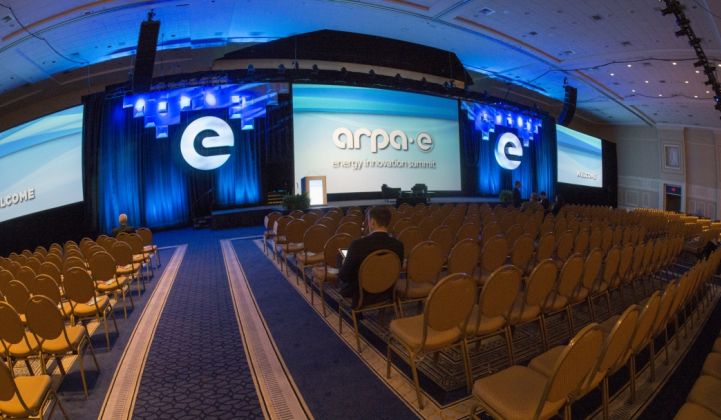The debate over how best to fund early-stage energy innovation took on a keen sense of urgency at the Department of Energy's ARPA-E Summit near Washington, D.C. this week.
Leading speakers at the advanced energy research agency's annual gathering Monday portrayed science funding as a matter of national interest and economic vitality. This was no academic debate: That same day, the Trump administration said it wants to boost the Pentagon's budget by $54 billion at the expense of other federal agencies. The exact sources of the cuts have not been publicly determined, but long-term R&D programs are under threat.
That prompted House Minority Leader Nancy Pelosi (D-Calif.) to declare, “The president is surrendering America’s leadership in innovation, education, science and clean energy.”
Over at National Harbor, on the banks of the Potomac River, the ARPA-E conference kicked off with a fireside chat starring MIT President L. Rafael Reif. It began with an explanation of The Engine, a new incubator where the university invested $25 million to support promising ideas until they can attract risk capital.
The conversation soon veered inside the Beltway, as Reif defended the role of government funding for basic science.
"This is not a conservative versus liberal point of view -- this is about the future of our nation," Reif said. "It's about making the connection that support for basic science and applied science is not a luxury we can afford when we are rich; it’s basically an investment in our future. [...] If we stop investing in basic science, forget about innovation."
He wasn't calling for federal dollars "in the marketplace of ideas," but insisted on the importance of federal support at the start of the chain of events leading to successful commercialization of a new technology.
In bygone decades, private business invested heavily in basic R&D, but the era of Bell Labs is over, Reif said. Few companies have the R&D capabilities to discover and nurture disruptive technology in-house, so they rely more on good ideas coming out of universities and national laboratories.
The funding question takes on geopolitical dimensions given the trajectories of other countries operating in this space.
"You'll be surprised at how fast the gap between our know-how and global know-how is closing," Reif said.
Later in the day, Representatives Mark Takano (D-Calif.) and Paul Tonko (D-N.Y.) expanded on the national security theme. In doing so, they made sure to include arguments for science investment that appeal to the motivations of leaders who aren't swayed by the weight of scientific consensus around climate change.
"This is about innovation, this is about leadership in the world economy, it's about national security and economic security," said Tonko, who previously served as president and CEO of the New York State Energy Research and Development Authority. "It's been proven, and now the proof is in the pudding."
A more resilient grid serves the interests of national defense and improves the nation's infrastructure, two priorities of the Trump administration. Takano, who co-chairs the Bipartisan Battery Energy Storage Caucus, even described its diverse supporters with a reference to Akira Kurosawa's 1950 movie that famously presented one event from several divergent perspectives.
"It’s kind of a Rashomon kind of caucus: You can take the point of view that batteries are good for fully utilizing renewables, but even if you’re in the climate-change-denier camp, you can also find very strong support for why we need to move the industry forward," he said.
These calls fell on receptive ears at an event filled with university researchers and early-stage entrepreneurs. Whether those arguments similarly succeed in the halls of Congress and the White House is a different matter.
ARPA-E, though, enjoys a history of bipartisan support. None other than President George W. Bush created the agency, after Congress passed the America COMPETES Act in 2007. That's a name and mission that sounds politically prescient these days.
Compared to more abstract basic science, ARPA-E has a clearer justification for its own existence: It gets easy-to-grasp results. In eight years, it has invested $1.5 billion in R&D funds to groups that have collectively won $1.8 billion in private follow-up funding. That's a 20 percent margin, directly helping to create new jobs via the 56 projects that have already developed into startups. Another 68 graduated to other government agencies to continue growing.
If that doesn't provide some insulation from budget pressures, it's hard to imagine what will.



